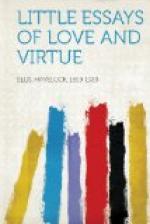If we seek to observe how the system worked some five hundred years ago when it had not yet become, as it is to-day, both weakened and disguised, we cannot do better than turn to the Paston Letters, the most instructive documents we possess concerning the domestic life of excellent yet fairly average people of the upper middle class in England in the fifteenth century. Marriage was still frankly and fundamentally (as it was in the following century and less frankly later) a commercial transaction. The wooer, when he had a wife in view, stated as a matter of course that he proposed to “deal” in the matter; it was quite recognised on both sides that love and courtship must depend on whether the “deal” came off satisfactorily. John Paston approached Sir Thomas Brews, through a third person, with a view to negotiate a marriage with his daughter Margery. She was willing, even eager, and while the matter was still uncertain she wrote him a letter on Valentine’s Day, addressing him as “Right reverent and worshipful and my right well-beloved Valentine,” to tell him that it was impossible for her father to offer a larger dowry than he had already promised. “If that you could be content with that good, and my poor person, I would be the merriest maiden on ground.” In his first letter—boldly written, he says, without her knowledge or license—he addresses her simply as “Mistress,” and assures her that “I am and will be yours and at your commandment in every wise during my life.” A few weeks later, addressing him as “Right worshipful master,” she calls him “mine own sweetheart,” and ends up, as she frequently does, “your servant and bedeswoman.” Some months later, a few weeks after marriage, she addresses her husband in the correct manner of the time as “Right reverent and worshipful husband,” asking him to buy her a gown as she is weary of wearing her present one, it is so cumbrous. Five years later she refers to “all” the babies, and writes in haste: “Right reverent and worshipful Sir, in my most humble wise I recommend me unto you as lowly as I can,” etc., though she adds in a postscript: “Please you to send for me for I think long since I lay in your arms.”




